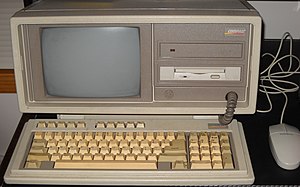Compaq Portable II
 |
|
| Manufacturer | Compaq Computer Corporation, United States |
|---|---|
| Type | Portable computer |
| Release date | February 20, 1986 |
| Introductory price | $3499 |
| Operating system | MS-DOS 3.1 |
| CPU | Intel 80286 @ 6 or 8MHz (dual-speed) |
| Memory | 256kB-640kB |
| Storage | 360kB 5.25" floppy drive, optional 10MB hard drive |
| Display | 9" Monochrome monitor |
| Graphics | 720×350 (text mode), 640×200 (graphics mode) |
| Sound | PC speaker |
| Input | Serial mouse, 84-key keyboard, light pen |
| Connectivity | CGA, composite, serial, parallel |
| Dimensions | 7.5" × 13.9" × 17.7" (10cm × 35.3cm × 45cm) |
| Weight | 23.6 lbs (10.7 kg) |
| Predecessor | Compaq Portable 286 |
| Successor | Compaq Portable III |
The Compaq Portable II was the third product in the Compaq portable series to be brought out by Compaq Computer Corporation. Released in 1986 at a price of US$3499, the Portable II was much improved upon its predecessors. It included an 8 MHz processor, and was lighter and smaller than the Compaq Portable. There were four models of the Compaq Portable II. The basic Model 1 shipped one 5.25" floppy drive and 256kB of RAM. The Model 2 added a second 5.25" floppy drive and sold for $3599. The Model 3 shipped with a 10MB hard disk in addition to one 5.25" floppy drive and 640kB of RAM for $4799 at launch. The Model 4 would upgrade the Model 3 with a 20MB hard drive and sold for $4999. The Compaq Portable II was significantly lighter than its predecessors, the Model 1 weighed just 23.6 pounds compared to the 30.5 pounds the Compaq Portable 286 weighed. Compaq only shipped the system with a small demo disk, MS-DOS 3.1 had to be purchased separately.
There are at least two reported cases of improperly serviced computers exploding when the non-rechargeable lithium battery on the motherboard was connected to the power supply. There were no recorded injuries. The Compaq Portable II was succeeded by the Compaq Portable III in 1987.
The Compaq Portable II had room for additional after market upgrades. Compaq manufactured four memory expansion boards, 512kB and 2048kB ISA memory cards and 512kB and 1536kB memory boards that attached to the back of the motherboard. With 640kB installed on the motherboard and both the ISA card and the expansion board, the computer could be upgraded with up to a maximum of 4.2MB of RAM. The motherboard also had space for an optional 80287 math coprocessor. There were two revisions of the motherboard, they were functionally identical although the earlier version was larger. The motherboard had four ISA slots for expansion cards, two 8-bit and two 16-bit. However, the first 16-bit slot was already occupied by a CGA graphics card and one of the 8-bit slots was used by the ATA drive controller board, leaving two available to add cards to. The keyboard is hardwired in but it uses standard PS/2 signaling, so a DIN or PS/2 socket can be retrofitted to allow use of common PS/2 keyboards (but not USB ones).
...
Wikipedia
